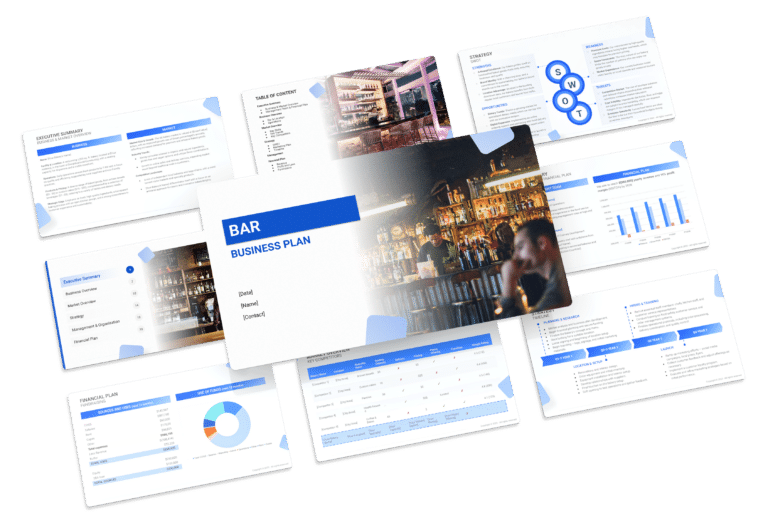Pizzeria Business Plan Template & PDF Example

Creating a comprehensive business plan is crucial for launching and running a successful pizzeria. This plan serves as your roadmap, detailing your vision, operational strategies, and financial plan. It helps establish your pizzeria’s identity, navigate the competitive market, and secure funding for growth.
This article not only breaks down the critical components of an pizzeria business plan, but also provides an example of a business plan to help you craft your own.
Whether you’re an experienced entrepreneur or new to the food&beverage industry, this guide, complete with a business plan example, lays the groundwork for turning your pizzeria concept into reality. Let’s dive in!
The Plan
Our pizzeria business plan is structured to cover all essential aspects needed for a comprehensive strategy. It outlines the pizzeria’s operations, marketing strategy, market environment, competitors, management team, and financial forecasts.
- Executive Summary: Offers an overview of the pizzeria’s business concept, market analysis, management, and financial strategy.
- Business Overview: Provides detailed information on what the pizzeria offers and its operational model:
- Restaurant & Location: Describes the pizzeria’s design, amenities, and why its location is appealing to potential customers.
- Supply & Operations: Lists the sourcing of ingredients, kitchen operations, and the service model of the pizzeria.
- Market Overview: Examines the pizza industry landscape, identifying competitors and how the pizzeria stands out:
- Key Stats: Shares industry size, growth trends, and relevant statistics for the pizza market.
- Key Trends: Highlights recent trends affecting the pizza sector, such as consumer preferences for artisanal and craft pizzas.
- Key Competitors: Analyzes main competitors in the vicinity and how the pizzeria differentiates from them.
- Strategy: Outlines how the pizzeria intends to achieve growth and attract clients:
- SWOT: Strengths, weaknesses, opportunities, and threats analysis.
- Marketing Plan: Strategies for attracting and retaining customers.
- Timeline: Key milestones and objectives from start-up through the first year of operation.
- Management: Information on who manages the pizzeria and their roles.
- Financial Plan: Projects the pizzeria’s financial performance, including revenue, profits, and expected expenses.

Executive Summary
The Executive Summary introduces your pizzeria’s business plan, offering a concise overview of your restaurant and its offerings. It should detail your market positioning, the variety of pizza and related Italian cuisine you offer, its location, size, and an outline of day-to-day operations.
This section should also explore how your pizzeria will integrate into the local market, including the number of direct competitors within the area, identifying who they are, along with your restaurant’s unique selling points that differentiate it from these competitors.
Furthermore, you should include information about the management and co-founding team, detailing their roles and contributions to the pizzeria’s success.
Additionally, a summary of your financial projections, including revenue and profits over the next five years, should be presented here to provide a clear picture of your restaurant’s financial plan.
Pizzeria Business Plan Executive Summary Example

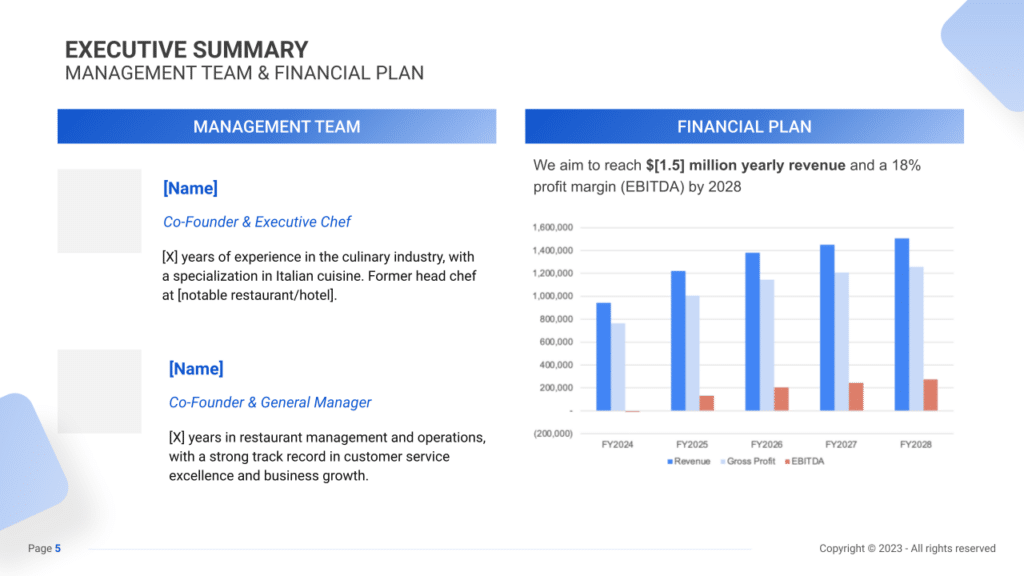
Business Overview
The business overview should highlight the pizzeria’s concept and branding, focusing on how it combines authentic Italian dining with modern twists. Emphasize the strategic location, facility design, menu selection, and the service model that caters to both dine-in and online orders.
Example:
“PizzaVivo,” located in the bustling Smithtown neighborhood, offers an authentic Italian dining experience. The pizzeria, with seating for 40 and an outdoor patio, features an open kitchen design for an interactive culinary experience. Its menu includes classic and innovative pizzas made with locally-sourced ingredients, along with appetizers and desserts, tailored to a range of dietary preferences.
Market Overview
This section should analyze the pizza industry’s size, growth, consumer trends, and the competitive landscape. It positions the pizzeria in the context of the market’s shift towards gourmet offerings, online convenience, and sustainability.
Example:
PizzaVivo enters a U.S. pizza market valued at over $46 billion. The trend towards artisanal pizzas and dietary variety, coupled with the rise in online ordering, positions PizzaVivo well in a market dominated by carry-out and delivery sales. Despite competition from various pizzerias, PizzaVivo’s unique dining experience and high-quality food set it apart.
Management Team
Detailing the management team’s experience and roles is crucial. This section should highlight how their background in culinary arts and restaurant management contributes to the pizzeria’s success.
Example:
The Executive Chef and Co-Founder of PizzaVivo, with extensive experience in Italian cuisine, leads the culinary direction. The General Manager, also a Co-Founder, brings years of experience in restaurant management and operations, ensuring excellent customer service and business growth.
Financial Plan
This section outlines the pizzeria’s financial goals and projections, including revenue targets and profit margins, offering insight into its financial aspirations and health.
Example:
PizzaVivo aims to achieve $1.5 million in annual revenue with an 18% EBITDA margin by 2028. This financial goal is underpinned by a focus on quality dining experiences, strategic marketing, and operational efficiency, positioning PizzaVivo for growth in the competitive pizza market.
Business Overview
For a Pizzeria, the Business Overview section can be effectively divided into 2 main categories:
Restaurant & Location
Briefly describe the pizzeria’s physical environment, focusing on its design, ambiance, and the welcoming atmosphere it creates for customers. Mention the restaurant’s location, highlighting its accessibility and the convenience it offers to customers, such as proximity to entertainment venues or ease of parking. Explain why this location is advantageous in attracting your target clientele.
Menu & Pricing
Detail the range of pizzas and related Italian cuisine offered, from classic Margheritas to innovative gourmet options, as well as any side dishes, desserts, and beverages. Outline your pricing strategy, ensuring it reflects the quality of ingredients used and matches the market you’re targeting. Highlight any specials, combo deals, or loyalty programs that provide added value to your customers, encouraging repeat visits and customer loyalty.
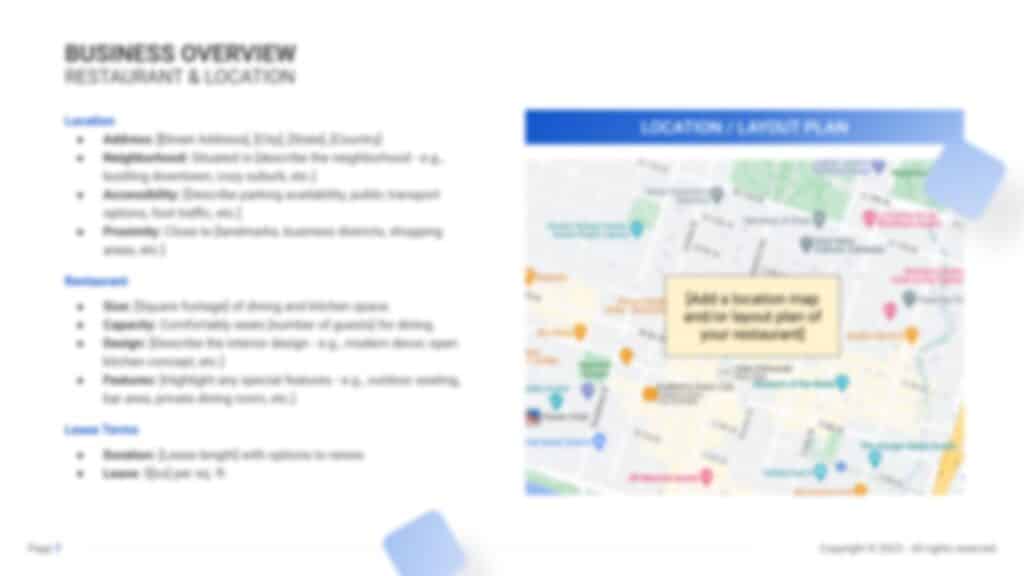
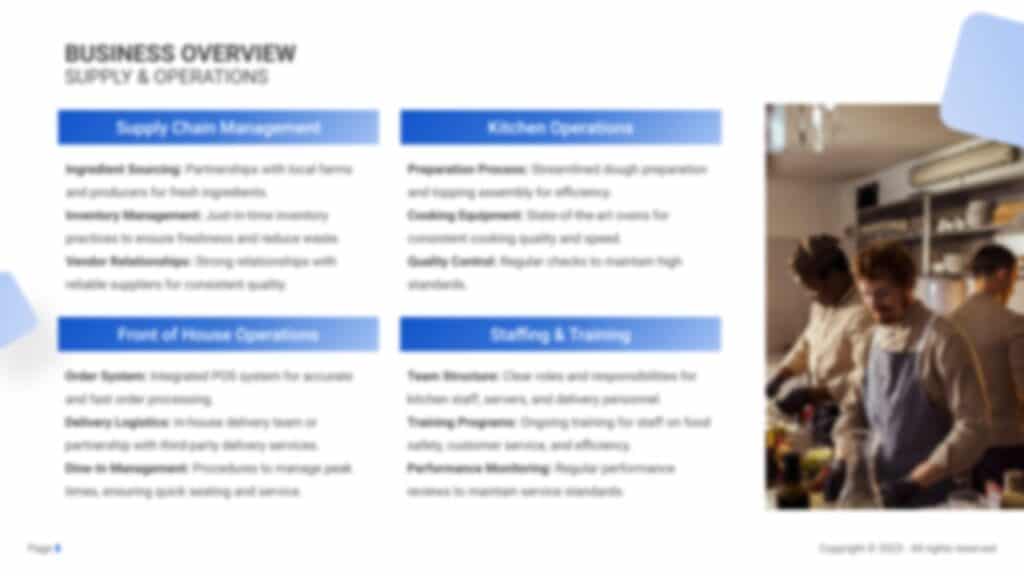
Market Overview
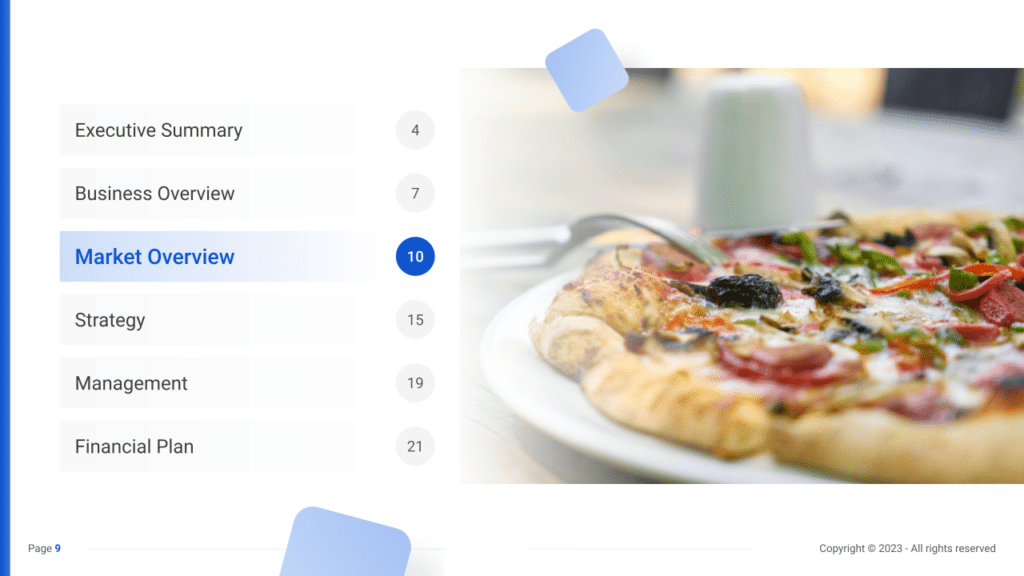
Industry Size & Growth
In the Market Overview of your pizzeria business plan, begin by exploring the size of the restaurant and fast-food industry, particularly focusing on the pizza sector, and its growth potential. This analysis is vital for understanding the market’s breadth and identifying opportunities for expansion.
Key Market Trends
Continue by discussing recent trends in the pizza industry, such as the growing consumer interest in artisanal and gourmet pizzas, the demand for gluten-free and vegan options, and the importance of sourcing local and organic ingredients. Highlight the trend towards fast-casual dining experiences where quality meets convenience, and the rise of technology in enhancing customer ordering and delivery services.
Competitive Landscape
A competitive analysis is not just a tool for gauging the position of your pizzeria in the market and its key competitors; it’s also a fundamental component of your business plan.
This analysis helps identify your pizzeria’s unique selling points, essential for differentiating your business in a competitive market.
In addition, competitive analysis is integral in laying a solid foundation for your business plan. By examining various operational aspects of your competitors, you gain valuable information that ensures your business plan is robust, informed, and tailored to succeed in the current market environment.
Identifying Your Competitors in the Pizzeria Restaurant
The initial step involves mapping out direct and indirect competitors in the local area. Direct competitors could be other pizzerias or Italian restaurants known for their pizza offerings. Indirect competition might come from fast-food chains serving pizza or even local diners offering a variety of dishes, including pizzas.
Tools like Google Maps help in visualizing the distribution of competitors across your locality. Additionally, online platforms such as Yelp, TripAdvisor, or local food blogs provide valuable insights into customer reviews and ratings. For instance, if reviews consistently praise “Crust & Crumble Pizzeria” for its wood-fired pizzas and cozy ambiance, this information could serve as a pivotal competitive advantage to emulate or differentiate from.
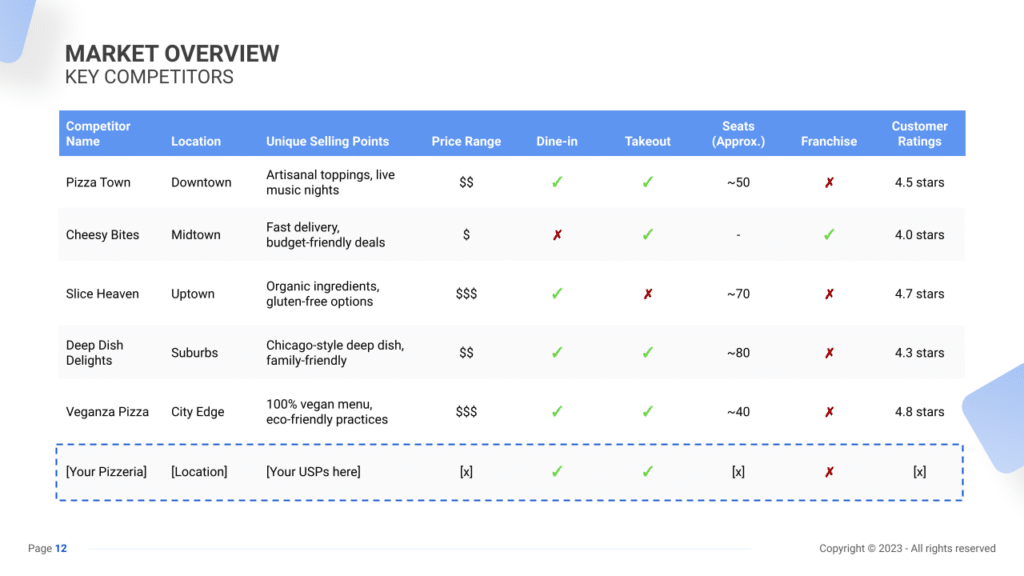
Pizzeria Restaurant Competitors Strategies
To conduct a thorough analysis, delve into the various strategies employed by your competitors:
- Pizza Menu Offerings: Assess the variety and uniqueness of pizza offerings. If a competitor like “Healthy Slice Pizzeria” gains traction with its emphasis on organic ingredients and gluten-free crusts, it signals a trend towards health-conscious dining that your pizzeria could consider incorporating.
- Preparation and Cooking Styles: Consider diverse pizza preparation methods. A pizzeria renowned for its Neapolitan-style pizzas might cater to a different customer base compared to one specializing in thick-crust Chicago-style pizzas or New York-style slices.
- Pricing Approaches: Compare your pricing strategy with that of competitors. Are you positioned similarly to budget-friendly pizzerias, or do you align more with high-end, gourmet pizza establishments?
- Marketing Tactics: Analyze how competitors market their offerings. Do they leverage social media marketing, community events, or loyalty programs to engage customers? Understanding these strategies can help you fine-tune your marketing initiatives.
- Customer Experience: Evaluate the dining experience offered by competitors. A pizzeria known for its family-friendly environment or quick and efficient delivery services might be setting benchmarks in customer satisfaction.
- Operational Innovations: Take note of technological advancements or innovative processes adopted by competitors. Whether it’s the use of online ordering systems, delivery apps, or eco-friendly packaging, such initiatives can impact customer convenience and satisfaction.
What’s Your Pizzeria’s Value Proposition?
Reflect on what makes your pizzeria unique in this competitive landscape. It could be your secret sauce recipe, a specialty pizza that’s exclusive to your restaurant, or a commitment to locally sourced ingredients.
Consider feedback from your customer base and industry trends to identify untapped market niches. For instance, the rising demand for plant-based options could be a potential avenue to explore, especially if competitors have yet to cater comprehensively to this segment.
Factor in the location of your pizzeria. A downtown location might emphasize fast service for busy customers, while a neighborhood-based pizzeria could focus on building a communal, relaxed dining atmosphere.
Strategy

SWOT
First, conduct a SWOT analysis for the pizzeria, highlighting Strengths (such as a diverse menu with high-quality ingredients and unique pizza recipes), Weaknesses (including potential high operational costs or stiff competition in the area), Opportunities (for instance, a growing demand for gourmet and artisanal pizzas), and Threats (such as fluctuations in food commodity prices that can affect cost margins or economic downturns that may impact discretionary spending on dining out).
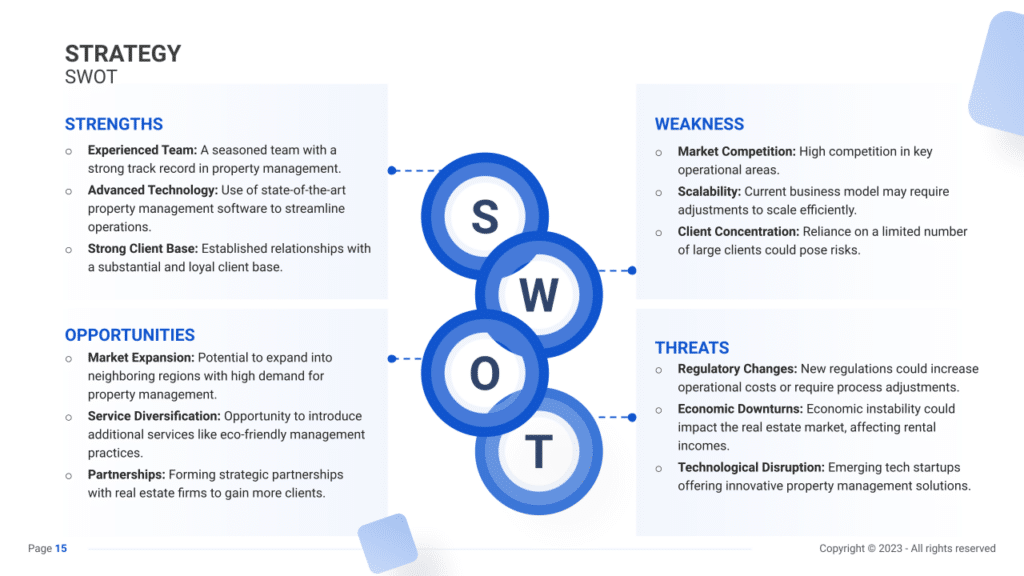
Marketing Plan
Next, develop a marketing strategy that outlines how to attract and retain customers through targeted advertising, promotional offers, a strong social media presence, and engagement with the local community. Consider loyalty programs, special pizza nights, or collaborations with local businesses and events to increase visibility and customer base.
Marketing Channels
Utilize various marketing channels to enhance brand visibility, engage customers, and drive foot traffic to your pizzeria.
Digital Marketing
Utilize online platforms effectively:
- Social Media: Engage customers on platforms like Instagram, showcasing mouthwatering pizza visuals, behind-the-scenes kitchen moments, and customer testimonials. Use Facebook for event promotions and Twitter for real-time interactions.
- Website and SEO: A well-designed website serves as a virtual storefront. It should not only display the menu and pricing but also provide an easy-to-use online ordering system, customer testimonials, and a blog sharing interesting stories about the history of pizzas, cooking tips, or interviews with chefs.
- Email Marketing: Build an email list offering exclusive deals or a free appetizer upon subscription. Send regular newsletters with promotions, new menu additions, and upcoming events.
Local Advertising
Connect with the local community:
- Community Engagement: Participating in community events, sponsoring local sports teams, or collaborating with neighborhood associations can create goodwill and increase brand visibility. Offering special discounts or free tastings at such events can attract new customers and create positive associations with the brand.
- Print Media: Traditional forms of advertising, like print media, shouldn’t be overlooked. Placing ads in local newspapers, magazines, or community newsletters can reach potential customers who might not be active on digital platforms. Distributing flyers or coupons in strategic locations or through direct mail campaigns can also drive foot traffic to the pizzeria.
- Partnerships: Collaborating with complementary local businesses can be mutually beneficial. For instance, partnering with nearby cinemas for combo deals or offering discounts for moviegoers who dine at the pizzeria before or after a show. Collaborations with schools for fundraising events or offering discounts to teachers and students can also expand the customer base.
Promotional Activities
Entice potential customers:
- Special Offers: Launch promotions like “Family Pizza Night” or “Two-for-One Slices” during off-peak hours. Offer discounts for first-time orders or loyal customers.
- Loyalty Programs: Implement a rewards system, providing a free pizza after a certain number of purchases or points earned.
- Referral Incentives: Offer discounts to customers who refer new patrons to your pizzeria.
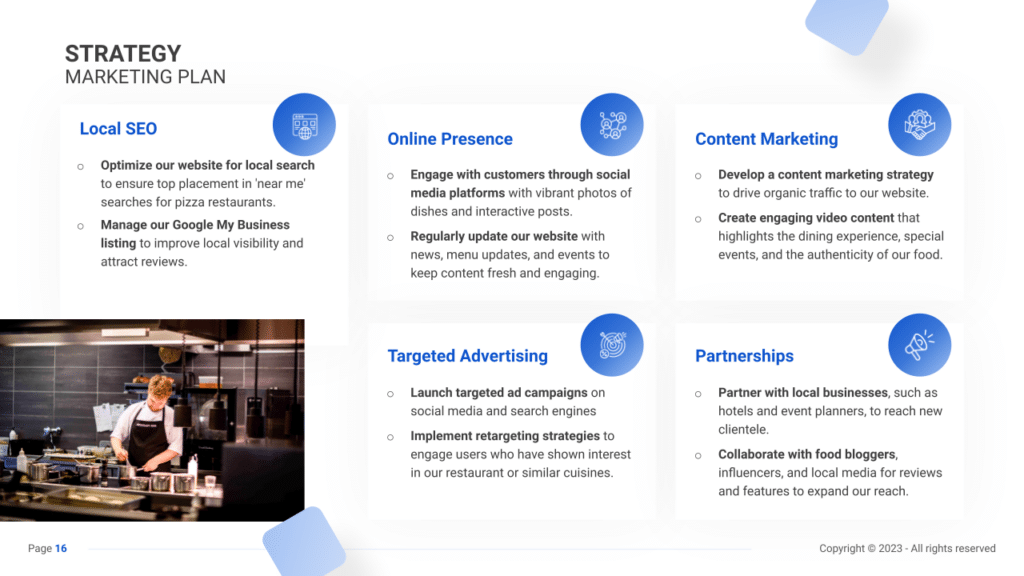
Sales Channels
Efficient sales channels enhance revenue streams and ensure customer satisfaction.
Dine-In Experience
Optimize customer experience:
- Upselling: Train staff to suggest add-ons like appetizers, desserts, or premium toppings during order-taking or table service.
- Customer Service: Emphasize excellent service, ensuring a pleasant dining experience that encourages repeat visits and positive word-of-mouth.
Takeout & Delivery Services
Efficient service for off-premise dining:
- Online Ordering: Provide an easy-to-navigate online ordering platform accessible through your website or mobile app.
- Delivery Efficiency: Ensure timely deliveries, offering special deals for delivery orders placed online or through the app.
Catering Services
Expand revenue opportunities:
- Corporate Events: Develop catering packages for office lunches or corporate events, emphasizing bulk orders or customizable menus.
- Private Parties: Promote your pizzeria for birthdays, anniversaries, or gatherings, offering tailored catering options and event space rental if available.
Strategy Timeline
Finally, create a detailed timeline that outlines critical milestones for the pizzeria’s launch, marketing initiatives, customer base development, and potential expansion goals, ensuring the business progresses with clear direction and purpose. Include key dates for menu updates, seasonal promotions, and community events participation to keep the momentum going and attract a steady flow of customers.

Management
The Management section focuses on the pizzeria’s management and their direct roles in daily operations and strategic direction. This part is crucial for understanding who is responsible for making key decisions and driving the pizzeria towards its financial and operational goals.
For your pizzeria business plan, list the core team members, their specific responsibilities, and how their expertise supports the business.


Financial Plan
The Financial Plan section is a comprehensive analysis of your financial projections for revenue, expenses, and profitability. It lays out your pizzeria’s approach to securing funding, managing cash flow, and achieving breakeven.
This section typically includes detailed forecasts for the first 5 years of operation, highlighting expected revenue, operating costs and capital expenditures.
For your pizzeria business plan, provide a snapshot of your financial statement (profit and loss, balance sheet, cash flow statement), as well as your key assumptions (e.g. number of customers and prices, expenses, etc.).
Make sure to cover here
_ Profit and Loss
_ Cash Flow Statement
_ Balance Sheet
_ Use of Funds








